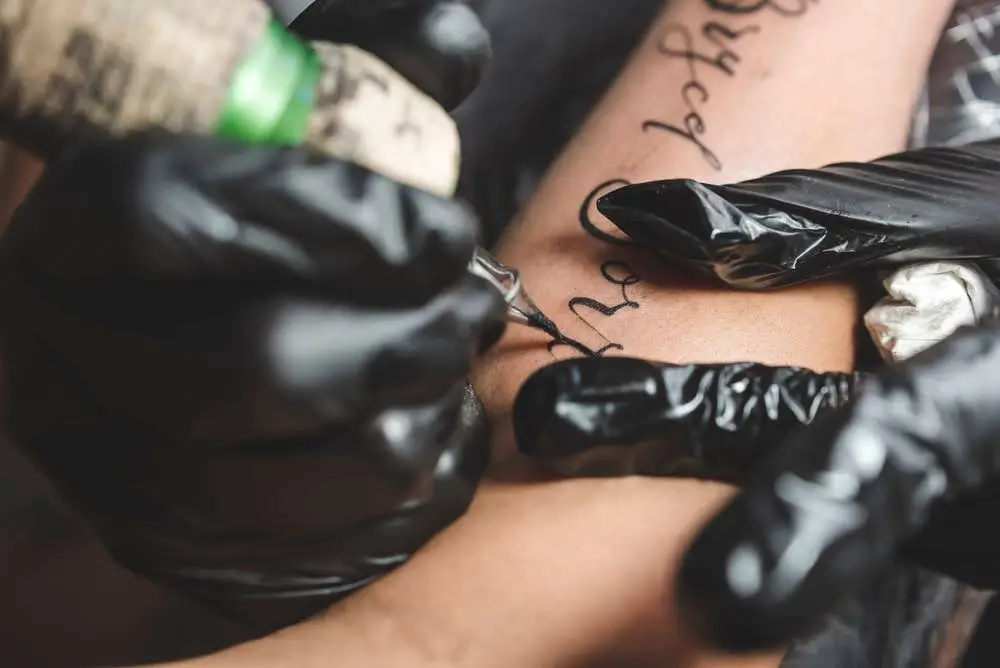Name tattoo styles have become increasingly popular in recent years, as people recognize the value of wearing their heart on their sleeve, or their loved ones’ names inked permanently on their skin. As a deeply personal form of expression, name tattoos hold special meaning for the individual and often serve as a reminder of a significant person or period in their life. This article will dive into the various aspects that make up the world of name tattoo styles, discussing their origins, variations, and impact on tattoo culture.

The art of name tattooing has a rich history and diverse roots in numerous cultures. As the styles and techniques continue to evolve, so does the variety of designs, font choices, and sizes available for tattoo enthusiasts. From minimalist single lines to elaborate script, the vast range of options for name tattoos makes it possible to find the perfect representation of one’s feelings and emotions.
As the tattoo community keeps growing and embracing the myriad of name tattoo styles, several subjects, influential artists, and unique design ideas are emerging to further enrich this form of personal expression. In a world where individuality and self-expression are celebrated, name tattoos stand as a powerful way to showcase one’s identity and values.
Key Takeaways
- Name tattoos are a uniquely personal form of expression with a rich cultural history.
- Various styles, fonts, and designs offer endless possibilities for creating meaningful name tattoos.
- The ever-evolving tattoo community embraces and influences the growth and development of name tattoo styles.
History and Culture
The history of name tattoo style is deeply intertwined with the broader history of tattooing. Tattooing has been practiced across various cultures for millennia, with preserved tattoos on ancient mummified remains providing evidence of its antiquity. Historically, tattoos have often been markers of social status, allegiance, or personal milestones.
In the context of American Traditional tattoos, the style emerged from the traditions of sailors. The 1700s marked the beginning of this tattoo lineage, as sailors used tattoos to mark milestones or for good luck. Infamous British explorer Captain James Cook played a key role in spreading these tattooing customs to the Western world. This connection to maritime culture still persists in the designs and motifs of Americana tattoos.
While name tattoos specifically might not have strong ties with Americana tattoos, the practice of tattooing names has transcended cultures. It is common for people to get names of loved ones, family members, or people they admire tattooed on their bodies as an expression of love, remembrance, or personal identification.
In many cultures, the act of tattooing carries great significance, with each style and method possessing its distinctive history and cultural symbolism. As name tattoos often combine elements of typography and design, they can act as powerful symbols that bridge the gap between one’s own identity and that of others in their lives.
Different Tattoo Styles
Tattoo styles have been constantly evolving as the art form has grown in popularity and artistic freedom. Each tattoo style comes with its own aesthetic and specific guidelines that artists use to create unique designs.
Traditional Tattoo Style, also known as American Traditional, is a classic style defined by bold outlines and a limited color palette. This style often features nautical imagery, female pinups, fierce predatory animals, and hearts, roses, or daggers. The tattoos are easy to recognize due to their iconic and timeless appeal.
Japanese Tattoo Style has a long and rich history, with designs heavily influenced by Japanese culture, folklore, and nature. This style is known for its complex compositions, with large-scale designs that often cover significant body parts. Typical motifs include koi fish, dragons, samurai, and cherry blossoms.
Realism Tattoo Style focuses on creating lifelike, detailed, and three-dimensional images. It often involves portraits, animals, and nature scenes that look authentic and true to life. Realism tattoos require exceptional skill as artists must be proficient with shading and color application to achieve a realistic appearance.
Geometric Tattoo Style is characterized by its use of geometric shapes, lines, and patterns to create captivating designs. These tattoos often feature intricate, symmetrical arrangements or abstract compositions that can be elaborate or minimalist, depending on the artist and client preference.
New School Tattoo Style is a modern evolution of American Traditional and showcases vibrant colors, exaggerated proportions, and a combination of multiple styles. It leans toward innovative and creative designs, often featuring pop culture themes, animated characters, or original creations by the artist.
Black and Grey Tattoo Style is perfect for those who prefer monochromatic designs. This style utilizes different shades of black and grey to create a distinct look, often by watering down the black ink for lighter shades. It’s versatile and can be applied to various tattoo styles, including realism or even abstract designs.
Blackwork Tattoo Style features bold, solid black ink and often includes tribal patterns, linework, and geometric shapes in its compositions. Stick and poke tattoos, a technique in which ink is applied manually by poking the skin, can fall under the blackwork umbrella depending on the design.
Each of these tattoo styles offers distinctive designs, techniques, and aesthetics. No matter what one’s personal preference might be, there is a style out there that can capture their personality and showcase their individuality through body art.
Fonts and Sizes
When choosing a font for your name tattoo, it’s essential to consider the style that best represents your personality and preferences. There are numerous fonts available, ranging from classic to modern and elaborate to minimalist.
Classic Fonts often feature elegant scripts or timeless serif fonts. These fonts include cursive scripts, Gothic styles, and traditional calligraphy. They may appear more formal or sophisticated, making them a popular choice for various name tattoos.
Modern Fonts encompass a variety of styles, from minimalist sans-serif to bold and eye-catching decorative fonts. These options are ideal for those seeking a contemporary, unique look for their name tattoo. Some popular modern fonts include clean, geometric designs or handwritten-style scripts.
Decorative and Themed Fonts can be an excellent choice if you want a tattoo that reflects a specific interest or theme. Such styles can include fonts inspired by graffiti, vintage signage, or even music and fashion. These fonts can be striking and visually compelling, adding personality to your name tattoo.
When selecting a font size, consider the tattoo placement and the desired level of visibility. Smaller and more delicate fonts can work well for subtle placements like wrists, fingers, or behind-the-ear tattoos. Larger and bolder fonts may be a better choice for more visible areas, such as forearms or shoulders, and can create a more striking visual impact.
Remember that the legibility of your name tattoo is essential. Choose a font size and style that will be easy to read, ensuring your tattoo remains a clear and meaningful representation of your chosen name.
Name Tattoo Subjects
A name tattoo is a personal and expressive way to honor a loved one, celebrate life milestones, or pay tribute to a significant relationship. These tattoos often incorporate various elements to further enhance the meaning and aesthetics of the design. In this section, we will discuss some popular subjects incorporated into name tattoos.
First, it’s common to see name tattoos combined with images of animals. Animals, such as birds, butterflies, or lions, can symbolize different aspects of one’s personality or a unique bond shared with the person whose name is tattooed. For instance, a lion may represent strength and courage, while a butterfly could signify transformation and rebirth.
Another popular subject found in name tattoos is various objects, including compasses, anchors, and skulls. These items can carry symbolic weight, adding depth to the overall meaning of the tattoo. For example, a compass might signify guidance and direction, while an anchor could symbolize stability and groundedness. Skulls, on the other hand, can represent overcoming adversity or serve as a reminder of life’s impermanence.
Flowers are frequently used alongside names in tattoo designs to represent both beauty and a sense of sentimentality. Roses, for example, are commonly associated with love and passion, making them a fitting choice when the name being tattooed is a romantic partner. Similarly, other flowers, such as lotus or lilies, may be chosen for their unique symbolism or personal significance.
Nature motifs, like plants, trees, and celestial elements, can also be incorporated into name tattoos. The organic forms of plants and trees can symbolize growth and transformation, often adding a sense of meaning to the tattoo. Celestial elements, like stars and moons, can suggest guidance or remind the bearer of the vastness of the universe and the finite nature of human life.
Techniques and Tools
Tattooing, a form of body art, requires skill and precision to achieve a desired look. Name tattoo styles, especially, need careful attention to detail since the design involves the use of letters and possibly additional elements such as heart, anchor, or fish symbols. To produce a quality name tattoo, tattoo artists employ various techniques and tools.
In a name tattoo, the ink and needles play a crucial role. High-quality ink ensures durability and vibrancy, while needles of different sizes allow fine details and bold lines. Single needle technique is frequently used for name tattoos, as it provides thin, precise lines that make the letters clear and legible.
Some name tattoos incorporate minimalist design, using simple forms and negative space to achieve a subtle yet elegant effect. An example of this would be a name enclosed within a simple heart outline. Utilizing negative space enhances the design and draws attention to the name itself.
When incorporating additional elements like anchor or fish symbols, tattoo artists must strike a balance between the lettering and the added imagery. It’s essential to keep the overall design cohesive, ensuring that the additional symbols enrich the name without overpowering it.
Practitioners often use various approaches to enhance the name tattoo style, including:
- Layering techniques: Overlapping colors or shapes to create depth, contrast, or texture in the design.
- Shading: Providing a sense of dimension and realism by adding gradients and shadows.
- Line work: Creating crisp, clean lines that form the foundation of the tattoo, especially for lettering or delicate shapes.
Tattoo artists customize their techniques and tools to create a unique name tattoo that suits the client’s preference and serves as a meaningful expression. With the right combination of craftsmanship and artistry, a name tattoo can become a beautiful and lasting tribute.
Influential Tattoo Artists
Tattoo art has evolved tremendously over the years, with many talented artists creating masterpieces on human skin. In this section, we will discuss a few of the most influential and renowned tattoo artists whose work has left an indelible mark in the world of tattoos.
George Burchett, also known as George ‘Professor’ Burchett, was an Englishman who was dubbed the ‘King of Tattooists.’ Burchett was the first celebrity tattooist and a favorite among European royals and the rich. His work was highly praised and set the standard for future artists in the tattoo industry.
Don Ed Hardy is another prominent figure in the tattoo world. Known for blending American and Japanese tattoo styles, Hardy’s distinct designs have catered to a global audience. His influence in the tattoo world cannot be overstated, as he helped bring tattoos into modern popular culture.
Horiyoshi III is a legendary Japanese tattoo artist, acclaimed for his mastery of the traditional hand-poke tattooing technique known as “irezumi.” His work revolves mostly around traditional Japanese designs and mythology, attracting clients from around the world with his exquisite craftsmanship.
Kat Von D gained fame for her appearance on the reality TV show, “LA Ink.” She has since become a household name in the tattoo industry, known for her intricate portraits and unique tattoo designs. Kat Von D’s work has inspired numerous artists and tattoo enthusiasts.
Vyvyn Lazonga is a pioneering female tattoo artist who has been in the industry for over four decades. She opened her tattoo studio in the 1970s and has been influential in breaking down gender barriers in the tattoo world. Lazonga is renowned for her vibrant, detailed, and creative designs.
These influential tattoo artists have shaped the art form we know today, leaving an indelible mark on the industry and inspiring the next generation of talented artists. Their contributions have pushed the boundaries of what’s possible in tattoo art and paved the way for numerous new styles and techniques.
Tattoo Design and Ideas
When it comes to name tattoo design, the possibilities are endless. From classical to modern styles, a wide array of options can be explored to best represent the person’s identity or to honor their loved ones. The following paragraphs will discuss some popular name tattoo ideas and how to create your own unique design.
One approach to tattoo design is to consider the appearance and values that you want to communicate. This can range from a simple, classic style with clean lines and minimal embellishments to abstract tattoos with vibrant colors and complex patterns. The art deco style, for example, can add an elegant and sophisticated touch to the name tattoo, with its distinctive geometrical shapes and ornate details.
When creating your own name tattoo, it is essential to use your imagination and personal preferences. Think about the elements that hold meaning to you, such as favorite colors, symbols, or interests. For example, if music is important to you, consider incorporating musical notes into the design. Alternatively, a butterfly could be used to symbolize transformation and personal growth.
Collaborating with a skilled tattoo artist can also help bring your vision to life. Share your ideas, values, and preferences with the designer, allowing them to recommend appropriate styles and techniques that align with your desired outcome. Their expertise will ensure that the final tattoo design is both visually appealing and representative of your individuality.
Commitment is a crucial aspect of name tattoos as they tend to be permanent reminders of the person or value they represent. Before going ahead with your decision, be confident that the name, design, and style you choose are meaningful and long-lasting. This will not only result in a stunning tattoo but also one that holds personal significance for years to come.
Colors and Tones
In name tattoo designs, the selection of colors and tones is crucial as it can significantly impact the overall appearance and visibility of the tattoo. The choices depend on the individuals’ preferences as well as the best match for their skin tone.
Black is a classic and popular choice for name tattoos, given its boldness and prominence on various skin tones. This color is versatile and timeless, making it suitable for different tattoo styles, from simple scripts to more elaborate designs.
Red and green are also commonly used in name tattoos, adding a touch of vibrancy to the design. These colors can enhance the visual appeal of the tattoo, making it stand out. However, the choice of red or green might not suit all skin tones. Generally, these colors look best on lighter skin shades, while darker skin tones may require brighter or contrasting colors for better visibility.
Bright colors are another option for those who want to add a striking or lively touch to their name tattoo. Bold hues like vivid blue or purple can complement the design and create a more eye-catching result. It is essential to consider whether these colors will work effectively on your skin tone, as some bright colors may not show up as clearly on darker shades.
When selecting colors and tones for your name tattoo, consider the purpose of the tattoo, its placement on your body, and how it will interact with your surroundings. Some color combinations may create a more harmonious and cohesive result, while others can create a stark contrast that draws attention to the design.
Ultimately, choosing the appropriate colors and tones for your name tattoo is a personal decision. Collaborate with your tattoo artist to determine the best options for your design and skin tone, ensuring a visually appealing and lasting result.
Placement on the Body
When choosing the placement for a name tattoo, there are several popular areas on the body that people tend to consider. Each area comes with its own set of advantages and factors to keep in mind.
Back: The back offers a large canvas, allowing for longer names or more intricate designs, such as banners or script fonts. It can be easily concealed and provides a relatively low pain level during the tattooing process.
Rib: Getting a name tattoo on the ribcage allows for vertical or horizontal placement and often looks elegant. However, the ribcage can be quite sensitive and might lead to a higher pain level, especially for those with a thin build.
Nape: Name tattoos placed on the nape (back of the neck) can be delicate and discreet, easily hidden by hair or clothing. It is an ideal area for small to medium-sized designs, but be aware that this spot can experience a moderate amount of pain during the tattoo process.
-
Fingers: Fingertip name tattoos are trendy and unique but have some limitations due to the small surface area. Names may need to be abbreviated, or a smaller font may be required. Keep in mind that tattoos in this area may also fade more quickly and require regular touch-ups.
-
Chest: The chest provides ample space for longer names or those wanting a prominent display. This area can be easily concealed or shown off depending on personal preference. Be prepared for a moderate to high level of pain, especially close to the collarbone.
-
Wrist: Name tattoos on the wrist have become increasingly popular due to their subtle and easily accessible placement. They can be placed horizontally or wrapped around the wrist, and are perfect for small or medium-sized designs. The pain levels for wrist tattoos can vary based on the individual’s pain tolerance and the specific location on the wrist.
Take the time to consider the ideal location for your name tattoo, keeping in mind factors such as pain tolerance, design size, and personal preferences. Choosing the right placement will ensure that your name tattoo is both meaningful and aesthetically pleasing.
Symbolism and Meanings
Name tattoos have long been a popular choice for people who want to express their love, tribute, or connection to someone. The symbolism of name tattoos is often deeply personal and carries a strong emotional significance.
One interesting aspect of name tattoos is the hidden meanings that can be incorporated into the design. For example, ambigram tattoos are designed to be read from multiple perspectives, allowing the name to be displayed right-side-up or upside-down. This type of tattoo adds a layer of complexity and personalization to the design, making it unique and special.
In some cases, people choose to incorporate additional elements into their name tattoos to convey specific meanings or themes. For instance, a feather can be added to a name tattoo to symbolize lightness, freedom, or spiritual connection. Similarly, other symbols such as a rose may be included to represent love, devotion, or beauty.
Another popular theme for name tattoos is courage. Various symbols and designs can be integrated with the name to signify bravery and strength. For example, a lion or a tiger, which are symbols of courage and power, can be included alongside the name to represent the person’s fearless nature.
Navigating the Inked World
In the realm of tattoos, name tattoo styles hold a special place. From honoring a loved one to showcasing your individuality, these tattoos are a versatile and timeless choice for those entering the inked world. Being confident and knowledgeable about the various design elements and approaches will help ensure that your name tattoo is a meaningful and lasting expression of your unique style.
One of the most popular design choices for name tattoos is to incorporate script or lettering, which can range from classic to ornate, depending on personal preference. Skilled tattoo artists can adapt font styles and sizes to create a unique representation of individual names, making these tattoos a perfect blend of personal attachment and artistic expression.
When considering name tattoos, it’s important to also think about placement. Traditionally, these tattoos are inked on visible locations like the forearm, wrist, or shoulder, symbolizing pride and commitment to the name embossed on the canvas of your skin. However, more discreet placements such as the ankle, behind the ear, or even on the collarbone can provide a more subtle approach for those who appreciate the sentiment but might not want the tattoo in plain sight.
Name tattoos are often associated with the inked world’s so-called “bad boys” – individuals who exude confidence and aren’t afraid to break stereotypes or define themselves through body art. While this reputation might be attributed to the popularity of name tattoos among musicians and actors in history, it’s important to remember that tattoos are ultimately a form of self-expression, and each person will carry their own unique story through their ink.
In the end, navigating the inked world with a name tattoo style comes down to your artistic vision, personal attachment to the name, and a collaboration with a skilled tattoo artist who can bring your ideas to life. By staying informed, confident, and clear about your desires, you can create a name tattoo that will hold its meaning and beauty for years to come.
Frequently Asked Questions
Which styles are popular for name tattoos?
There are several popular styles for name tattoos, including script, calligraphy, and typewriter font. Script and calligraphy styles are often chosen for their elegance and fluidity, while typewriter font provides a more vintage and nostalgic feel. Watercolor tattoos are also trending, adding a splash of color and artistry to the design.
How can I design a unique name tattoo?
To design a unique name tattoo, consider experimenting with various fonts, sizes, and placements. You can also play with different color combinations, shadows, or embellishments like banners, flowers, or shapes, to create a personalized piece of body art. Consult with a professional tattoo artist to help bring your vision to life and create a design that represents you.
Do certain fonts work better for name tattoos?
Yes, some fonts work better for name tattoos due to their readability and adaptability to different body placements. Script and calligraphy fonts are popular choices due to their legibility and aesthetic appearance. However, it’s important to choose a font that resonates with your personal style and preference.
What are the best placements for name tattoos?
The best placements for name tattoos depends on personal preference, size, and visibility. Common placements include the wrist, forearm, shoulder, back, and ankle. Smaller name tattoos are often placed on the collarbone, finger, or behind the ear. Consider factors such as your profession, daily attire, and pain tolerance when choosing the ideal location for your name tattoo.
How can I incorporate symbols or images into a name tattoo?
Incorporating symbols or images into your name tattoo can add personal connections or artistic elements to your design. Choose a symbol that represents your personality, interests, or cultural heritage. Some examples include hearts, stars, flowers, or religious symbols. You can also opt for images that complement the name or create a visual balance in the design. Consult with your tattoo artist to find the best way to include these elements without compromising the legibility of the name.
Is it easy to change or cover up a name tattoo later on?
Changing or covering up a name tattoo later on may be challenging, depending on the size, location, and design of the original tattoo. Smaller, simpler designs are generally easier to modify or cover up, while larger, more intricate ones may require a more skilled artist or specialized techniques. It’s crucial to carefully consider the permanence of a name tattoo and seek professional advice if you’re unsure about the design or placement.


